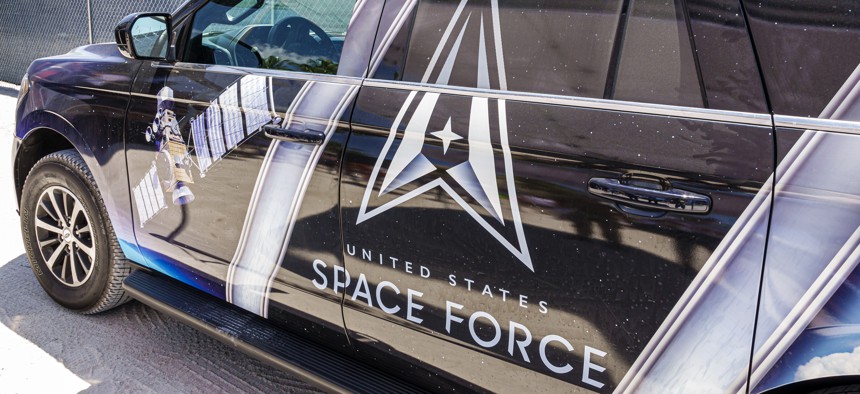
This U.S. Space Force vehicle flashed a mean paint job at the Hyundai Air & Sea Show at Military Village in Miami Beach, Florida, on May 28, 2022. Jeffrey Greenberg/Universal Images Group via Getty Images
Recruiting Crisis? Not at Space Force
The youngest and smallest service says it pays to be both choosy and inclusive.
Unlike its sister services, the U.S. Space Force has little trouble recruiting, according to the branch’s former chief. Being small helps, as does giving opportunities to some who might get rejected by another branch. The main challenge turns out to be spotting the best talent among pools of hundreds of applicants.
“There's been news that there's a recruiting challenge. We haven't seen that in the Space Force,” John “Jay” Raymond, who recently retired as Space Force’s first chief of staff, said Thursday during a Henry L. Stimson Center event. “We only recruit several hundred a year. Rather than thousands and thousands and thousands. So it's an easier challenge. But I will tell you, we have more people knocking on our door than we can take.”
Raymond said Space Force recruiters spend more time assessing potential recruits than persuading them to join up.
“What we've done is, we use the recruiters now to get the pool of people. We bring them in and we do assessments on them. And then we have a board and we pick which ones are coming in and the quality of our folks—and not that we were bad before—but the quality of our folks both on the enlisted side and the officer side is through the roof.”
For example, when the Space Force went looking for cyber professionals who had worked in private industry, hundreds of people applied. The service took six of them.
Some were given direct commissions at the ranks of first lieutenant and lieutenant colonel, Raymond said. Use of direct commissioning is expected to be expanded to other career fields too, including operations, intelligence, engineering and acquisition.
Other parts of the military have been struggling with meeting their recruiting numbers, partly due to bad publicity, and have been looking for various ways, including tech, to drive interest.
The military’s youngest and smallest service has about 8,400 personnel, which Raymond said permits more workforce development.
“It's never going to be complete. You're always going to work towards this idea, but I really believe it will be a model for others to emulate. Because we weren't going to use current century personal development practices. And I'm very proud of the team that put all that together,” the retired four-star said.
The Space Force has locations in or near metropolises in Colorado, California and Florida, which could be an advantage. So can desk-friendly, computer-based jobs.
“Because of the nature of our force, the numbers and locations and where we do our missions, what might not be acceptable for another service might be perfect for the Space Force,” Raymond said. “There's still work to do. But the Space Force is making some good initial steps.”
The approach, from assessments to a focus on workforce development and management, is something other services struggling with recruiting and retention could emulate, said Herbert “Hawk” Carlisle told Raymond at the Stimson event.
“We had folks that loved the Air Force; didn't want to get out but [they had] elderly parents, childbirth,” or wanted to continue their education, said Carlisle, who used to lead Air Combat Command. “It sounds like you're able to be bold and be able to do some of those things from the birth of your service. Hopefully that will translate to some of our other services.”




